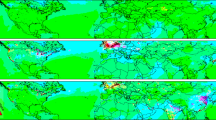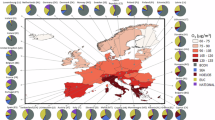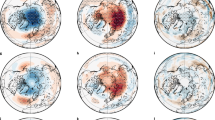Abstract
OZONE in the troposphere is an important greenhouse gas, and a key participant in the oxidation of other trace species, but the mechanisms for its formation and destruction are not fully understood. In polluted regions of the Northern Hemisphere, seasonal increases in ozone concentration have been observed1,2; such changes could arise from photochemical reactions3–6, but they could also involve transport from the ozone-rich stratosphere7. In remote, unpolluted (low-Nox) regions, photochemical theory predicts net destruction of ozone8. Here we present observations of a large summer minimum in ozone concentration in the unpolluted marine boundary layer of the Southern Hemisphere. Our results show a clear link between ozone loss and hydrogen peroxide production in the region, demonstrating that in situ photo-chemistry, rather than transport, is the major cause of the seasonal ozone cycle in the boundary layer. These findings emphasize the role of photochemical processes in the lower atmosphere, and may suggest only a limited role for transport in other, more polluted regions.
This is a preview of subscription content, access via your institution
Access options
Subscribe to this journal
Receive 51 print issues and online access
$199.00 per year
only $3.90 per issue
Buy this article
- Purchase on SpringerLink
- Instant access to full article PDF
Prices may be subject to local taxes which are calculated during checkout
Similar content being viewed by others
References
Penkett, S. A. in The Changing Atmosphere (eds. Rowland, F. S. & Isaksen, I. S. A. 38–48) (Wiley, New York, 1988).
Fehsenfeld, F. C. et al. J. atmos. Chem. 1, 87–105 (1983).
Levy, H. Science 173, 141–143 (1971).
Levy, H. Planet. Space Sci. 20, 919–935 (1972).
Crutzen, P. Pure appl. Geophys. 106–108, 1385–1399 (1973).
Chamiedes, W. L. & Walker, J. C. G. J. geophys. Res. 78, 8751–8760 (1973).
Levy, H. J. geophys. Res. 90, 3753–3772 (1985).
Fishman, J. & Crutzen, P. J. Nature 274, 855–858 (1978).
Johnson, J. E. et al. J. geophys. Res. 95, 121847–11856 (1990).
Lazrus, A. L. et al. Analyt. Chem. 58, 594–597 (1986).
Elsworth, C. M., Galbally, I. E. & Douglas, M. D. in Atmospheric Ozone (eds Zerofos, C. S. & Ghazi, A.) 809–814 (Reidel, Dordrecht, 1984).
Ayers, G. P. & Gras, J. L. J. geophys. Res. 88, 10655–10659 (1983).
Baseline 76–89, Annual Reports (1976–1989) of the Baseline Atmospheric Program, Australia (Department of Arts, Sport, the Environment, Tourism and Territories, Canberra).
Madronich, S. & Calvert, J. G. J. geophys. Res. 95, 5697–5715 (1990).
Pittock, A. B. Q. JI R. met. Soc. 103, 575–584 (1977).
Garrat, J. R. The Atmospheric Boundary Layer (Cambridge Univ. Press, 1992).
Galbally, I. E. & Roy, C. R. Q. JI R. met. Soc. 106, 599–620 (1980).
Bentley, S. T. & Ayers, G. P. in Baseline 89, 30–37 (Department of Arts, Sport, the Environment, Tourism and Territories, Canberra, 1991).
Ridley, B. A., Carroll, M. A. & Gregory, G. L. J. geophys. Res. 92, 2025–2047 (1987).
Fraser, P. J. & Hyson, P. J. atmos. Chem. 4, 3–42 (1986).
Schmidt, R. et al. in EUROTRAC A. Rep. 1990 Part 9 (EUROTRAC International Scientific Secretariat, Garmisch-Partenkirchen, 1991).
O'Connor, T. & Simmonds, P. in EUROTRAC A. Rep. 1991 Part 9 (EUROTRAC International Scientific Secretariat, Garmisch-Partenkirchen, 1992).
Author information
Authors and Affiliations
Rights and permissions
About this article
Cite this article
Ayers, G., Penkett, S., Gillett, R. et al. Evidence for photochemical control of ozone concentrations in unpolluted marine air. Nature 360, 446–449 (1992). https://doi.org/10.1038/360446a0
Received:
Accepted:
Issue date:
DOI: https://doi.org/10.1038/360446a0
This article is cited by
-
Spatial-temporal variations in surface ozone over Ushuaia and the Antarctic region: observations from in situ measurements, satellite data, and global models
Environmental Science and Pollution Research (2018)
-
Variability of ozone in the marine boundary layer of the equatorial Pacific Ocean
Journal of Atmospheric Chemistry (2010)



